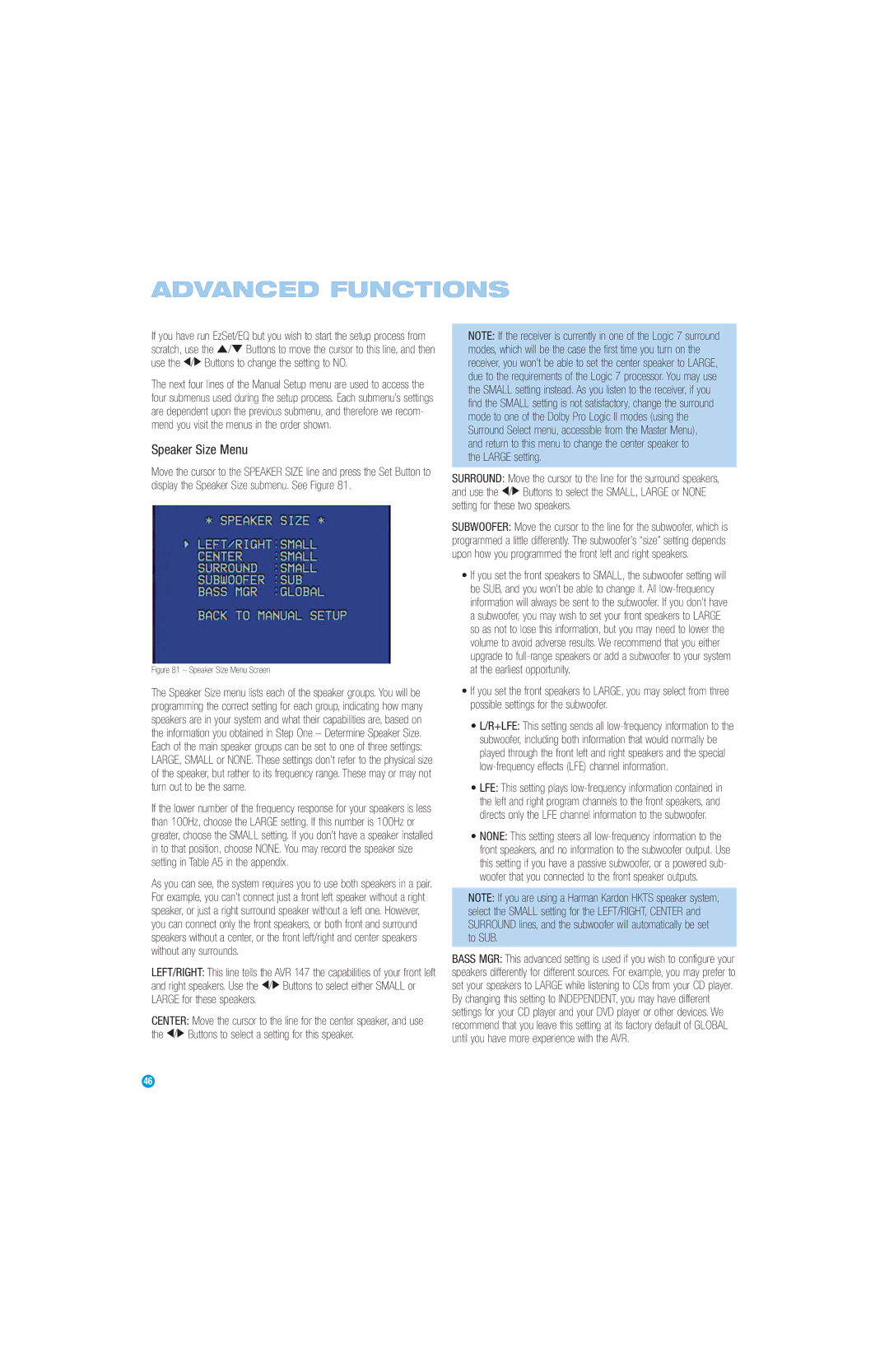If you have run EzSet/EQ but you wish to start the setup process from scratch, use the ⁄/¤ Buttons to move the cursor to this line, and then use the ‹/› Buttons to change the setting to NO.
The next four lines of the Manual Setup menu are used to access the four submenus used during the setup process. Each submenu’s settings are dependent upon the previous submenu, and therefore we recom- mend you visit the menus in the order shown.
Speaker Size Menu
Move the cursor to the SPEAKER SIZE line and press the Set Button to display the Speaker Size submenu. See Figure 81.
Figure 81 – Speaker Size Menu Screen
The Speaker Size menu lists each of the speaker groups. You will be programming the correct setting for each group, indicating how many speakers are in your system and what their capabilities are, based on the information you obtained in Step One – Determine Speaker Size. Each of the main speaker groups can be set to one of three settings:
LARGE, SMALL or NONE. These settings don’t refer to the physical size of the speaker, but rather to its frequency range. These may or may not turn out to be the same.
If the lower number of the frequency response for your speakers is less than 100Hz, choose the LARGE setting. If this number is 100Hz or greater, choose the SMALL setting. If you don’t have a speaker installed in to that position, choose NONE. You may record the speaker size setting in Table A5 in the appendix.
As you can see, the system requires you to use both speakers in a pair. For example, you can’t connect just a front left speaker without a right speaker, or just a right surround speaker without a left one. However, you can connect only the front speakers, or both front and surround speakers without a center, or the front left/right and center speakers without any surrounds.
LEFT/RIGHT: This line tells the AVR 147 the capabilities of your front left and right speakers. Use the ‹/› Buttons to select either SMALL or LARGE for these speakers.
CENTER: Move the cursor to the line for the center speaker, and use the ‹/› Buttons to select a setting for this speaker.
NOTE: If the receiver is currently in one of the Logic 7 surround modes, which will be the case the first time you turn on the receiver, you won’t be able to set the center speaker to LARGE, due to the requirements of the Logic 7 processor. You may use the SMALL setting instead. As you listen to the receiver, if you find the SMALL setting is not satisfactory, change the surround mode to one of the Dolby Pro Logic II modes (using the Surround Select menu, accessible from the Master Menu), and return to this menu to change the center speaker to
the LARGE setting.
SURROUND: Move the cursor to the line for the surround speakers, and use the ‹/› Buttons to select the SMALL, LARGE or NONE setting for these two speakers.
SUBWOOFER: Move the cursor to the line for the subwoofer, which is programmed a little differently. The subwoofer’s “size” setting depends upon how you programmed the front left and right speakers.
•If you set the front speakers to SMALL, the subwoofer setting will be SUB, and you won’t be able to change it. All low-frequency information will always be sent to the subwoofer. If you don’t have a subwoofer, you may wish to set your front speakers to LARGE so as not to lose this information, but you may need to lower the volume to avoid adverse results. We recommend that you either upgrade to full-range speakers or add a subwoofer to your system at the earliest opportunity.
•If you set the front speakers to LARGE, you may select from three possible settings for the subwoofer.
•L/R+LFE: This setting sends all low-frequency information to the subwoofer, including both information that would normally be played through the front left and right speakers and the special low-frequency effects (LFE) channel information.
•LFE: This setting plays low-frequency information contained in the left and right program channels to the front speakers, and directs only the LFE channel information to the subwoofer.
•NONE: This setting steers all low-frequency information to the front speakers, and no information to the subwoofer output. Use this setting if you have a passive subwoofer, or a powered sub- woofer that you connected to the front speaker outputs.
NOTE: If you are using a Harman Kardon HKTS speaker system, select the SMALL setting for the LEFT/RIGHT, CENTER and SURROUND lines, and the subwoofer will automatically be set to SUB.
BASS MGR: This advanced setting is used if you wish to configure your speakers differently for different sources. For example, you may prefer to set your speakers to LARGE while listening to CDs from your CD player. By changing this setting to INDEPENDENT, you may have different settings for your CD player and your DVD player or other devices. We recommend that you leave this setting at its factory default of GLOBAL until you have more experience with the AVR.

